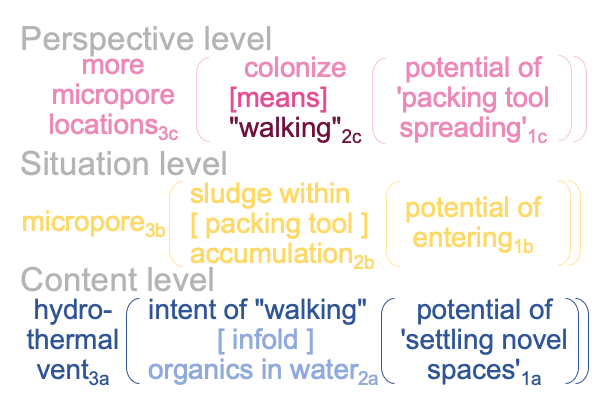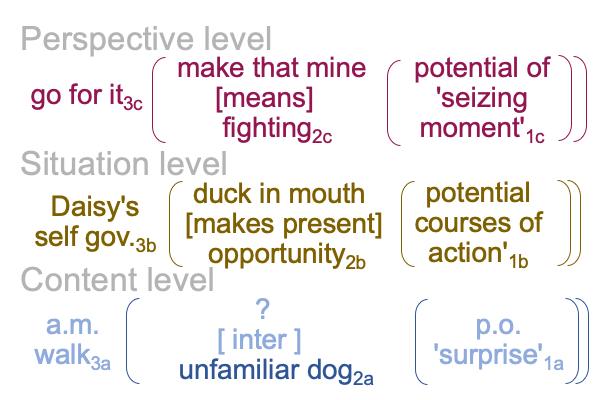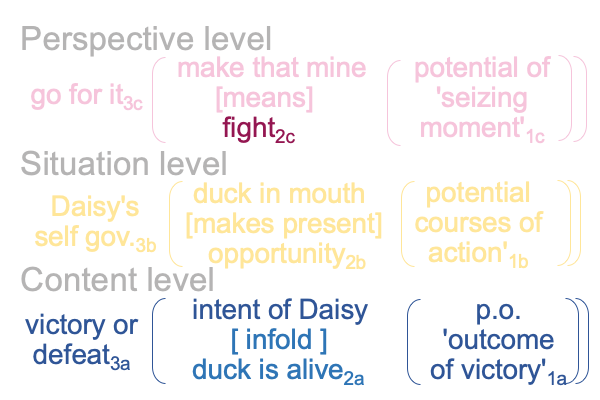0959 Let me say that again, while focusing on the actualities.
From the outside, organic molecules may pulse into a micropore. That corresponds to [inter]. The same organic molecules tend not to leave, because they bind to the walls of the micropore (through charged interactions and dipoles) or slough out of water solution into the sludge (because water forms hydrogen bonds that exclude many organic molecules).
0960 Particularly configured organic molecules end up getting synthesized as these molecules occasionally covalently bond with one another. They can form strings, where an organic (hydrophobic) macromolecule has two polar (hydrophilic and glass-loving) ends that can direct molecules entering the micropore to the crystal surface (for electrostatic attraction). The hydrophobic string can direct molecules towards the organic crud (for getting out of water).
They are like hydrophobic strings with electrostatic glue on either end.
They emerge within sludge [packing tool] accumulation2b.
0961 If one of these peculiar molecules leaves the micropore, it can “walk” along the glass surface with one end electrostatically holding on to the glass surface and the other coming loose and floating as far as the string allows before coming back to the glass surface.
In this way, one molecule can “walk” to another micropore2a and catalyze the process of accumulation2b if it is not already happening.
0962 And, that manifests [meaning] by instigating an interventional sign.

Biphasic macromolecular “walking” along the lining of a hydrothermal vent2c (SVi) stands for further settlement of porous space2a (including micropores already spontaneously accumulating) (SOi) in regards to the potential of ‘settling novel spaces’1a in the normal context of a hydrothermal vent3a (SIi).
Notice that in the picture, the {SOi}2a is the intent expressed by “walking”, rather than further settlement of porous spaces.
0963 Also, I replace [inter], the technical word for [message], with [infold] because the message comes from within the system. Here, the message, [infold], barely applies. But, when the normal context3a belongs to a subagent, then the term definitely applies.
0964 Back in point 0946, the author asks whether there can be potential meaning in a world without meaning (that is, life)?
The answer applies to section 7.6 (Potential Meanings and Complexity of the Non-living World) and 7.7 (Actualization of Potential Meanings by Organisms).
0965 Does the answer also apply to section 7.8 (Potential Signs and Meanings in Human Life)??
Let me go back to that preposterous story about Daisy and the duck.
0966 Here is a picture of how the incident provokes Daisy’s semiotic agency. The picture is written in the style of a three-level interscope, for the convenience of this examiner.

0967 At the start of the incident, the sudden appearance of an unfamiliar dog pulling out something from a pile of dead leaves2a (SVs) stands for a duck in its mouth2b (SOs) in regards to Daisy’s self-governance3b operating on potential courses of action1b (SIs).
The encounter with another dog is like a sensation2a. Realizing that a duck is in the other’s dog mouth is like a perception2a.
0968 The duck in the other’s dog mouth2b (SOs) [makes present] an opportunity2b (SVe).
Daisy’s opportunity2b (SVe) stands for the goal of making the duck mine2c (SOe) in regards to the normal context of going for it3c operating on the potential of ‘seizing the moment’1c (SIe).
0969 The perspective-level actuality2c has the character of a judgment. Daisy’s canine intellect (relation, thirdness) brings the intelligibility of the getting the duck in the other dog’s mouth (what ought to be, secondness) into relation with the universality of Daisy’s sizing up the other dog (what is, firstness).
Say what?
If Daisy’s sizing up the other dog is correct, then she bets that she can get the duck.
0970 Her goal of making that duck her own (SOe) [means] a fight (SVi).
0971 [Meaning] connects semiotic agency to an interventional sign-relation.
This is Daisy’s intervention. I am along as an ally who is capable of throwing rocks. When the first rock hits solidly, and the other dog looks over at me, I think, “I should have held tighter onto Daisy’s leash.” Just kidding, I really think, “Wow. That got his attention.”
Then, I throw the second rock and it misses completely.
0972 Once Daisy positions herself to prevent the other dog from bolting with the prize. The wandering hound must prepare for a fight. That means that he must put down the duck. Then, the third rock lands and its over.
For me, I know that the interventional sign-vehicle (SVi) has played its course when I pick up Daisy’s leash, still attached to her bodice, and she noses the duck and looks up.
0973 Here is a picture of the interventional sign-relation.

Daisy’s fight2c (SVi) stands for her intent at the moment of victory2a (SOi) in regards to victory or defeat3a operating on the potential that the victory affords a message’1a (SIi).
0974 The [message] is [infolds] because Daisy and I are now a team.
The intention of Daisy2c [infold] duck is alive2a.
